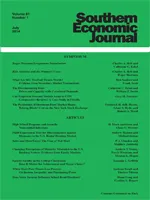- | Academic & Student Programs Academic & Student Programs
- | Journal Articles Journal Articles
- |
Changing Perceptions of Maturity Mismatch in the US Banking System: Evidence from the Equity
Originally published in Southern Economic Journal
This paper uses the sensitivity of bank holding company equity returns to market interest rates as an indicator of perceived maturity mismatch.

This paper uses the sensitivity of bank holding company equity returns to market interest rates as an indicator of perceived maturity mismatch. Based on data from 1990 to 2009, there is only weak evidence that market participants perceived banks to be effectively short-funded. However, looking at 1990–1996 and 1997–2009 subsamples separately, this paper's results suggest that U.S. commercial banks were perceived as short-funded during the earlier time period but not the later. During this time of changing perceptions of maturity mismatch, banks were increasing their holdings of real estate loans as a share of total assets. This paper presents evidence that, subsequent to 1996, market participants perceived real estate loans as having become effectively shorter-term.
Find article at Southern Economic Journal.
To speak with a scholar or learn more on this topic, visit our contact page.

